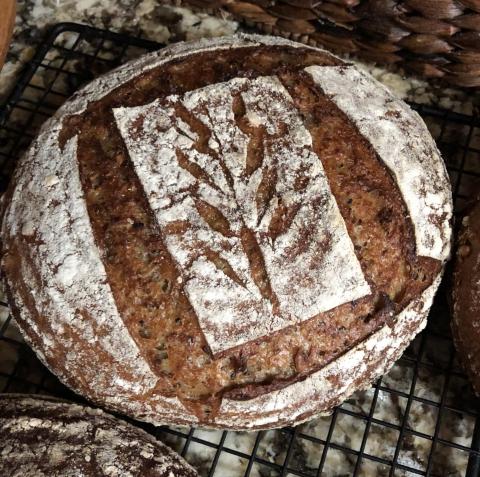
Four Seeds Multigrain Sourdough

I don’t usually bake mid week, but I had requests from family and friends who needed bread ASAP! I was also asked to repeat the 5 grain levain loaves but since I like to try different combinations, I thought I would take inspiration from Frank’s Let’s Blame CNN bread and Hamelman’s 5 grain levain.
I was going to retard the levain it since time was of the essence, I ended up going for a young levain. It seemed to be quite active and rose nicely in spite of short timelines.
I also tried something I have never done before and that was to proof the boules seam side up. In the past, even if I scored the boules, which I rarely do, I still placed the boules seams side down in the bannetons. I thought that maybe I am missing out on a secret on something seemingly so simple so why not! Maybe I’ll get nice ears. ?
Recipe
Makes 3 loaves
Soaker
50 g sunflower seeds
25 g sesame seeds
25 g chia seeds
50 g old fashioned oats (large flake)
Soak in 150 g hot water
Dough
50 g high extraction buckwheat flour (mill 75 g of buckwheat groats)
100 g high extraction rye flour (mill 125 g of rye berries)
200 g high exraction red fife flour (mill 250 g of red fife berries)
650 g unbleached flour
50 g freshly ground flax
12 g vital wheat gluten
11 g diastatic malt (mill 11 g of row 2 barley malt berries)
775 g filtered water at 89F (divided)
30 g yogurt
20 g salt
200 g bran 3 stage Levain
The day before:
- In mid afternoon, take a teaspoon full of your refrigerated starter and feed it equal quantities of filtered water and unbleached flour. Let it activate for the rest of the day.
- Mill the grains (red fife, rye, buckwheat) and sift out the bran. The buckwheat had practically no bran to speak of. I ended up with 30 g of bran.
- Mill and sift the malt barley berries to get diastatic malt powder.
- Grind the flax seeds in a bullet (Komo recommends against milling oily seeds like flax in their mills).
- Weigh the high extraction (sifted) flours needed and place in a tub. To the tub, add the diastatic malt, the vital wheat gluten and the ground flax. Stir well to distribute the malt and the VWG, cover, and reserve.
- Save the bran and the extra high extraction flour for the levain. I was a bit short so I needed another 5 or so grams of unbleached flour to make up the difference. I needed a total of 100 g of bran and leftover flour for the next two stages of the levain.
- Before going to bed, add 30 g of water to the revived starter, stir and add the bran. Let sit overnight.
Dough making day:
- In the morning, do the last build of the levain by adding 70 g of the extra high extraction flour/unbleached flour and 70 g water. Place in a warm spot. The levain doubled in 4 hours.
- Two hours after doing the final feeding of the Levain, add 725 g of warm water to the flour tub and autolyse for 2 hours or until the levain has doubled.
- Toast the seeds and oats for the soaker in a dry frying pan and soak them in the hot water.
- Once the levain is ready, add the salt, the yogurt and the levain as well has 50 g water, and mix well to integrate. Do 50 in tub folds and let rest 30 minutes in the oven with the lights on and the door cracked open (~82F).
- Do one set of 8 stretches and folds. Place back in the warm spot for another 30 minutes.
- Do another set of folds in the tub and then take the dough out of the tub onto a barely damp counter. Spread the dough out in a large rectangle and sprinkle with part of the toasted seed mixture. Fold the dough into envelope folds and sprinkle more seeds on the bare spots. Do gentle coil folds until the seeds are well integrated. Place the dough back into the tub, cover and place back into the warm spot.
- Do one last fold 30 minutes later. At this point the dough should be holding its shape for a while after folding. Let rest. Bulk fermentation is done when you can see small and large bubbles on the surface. This dough took about 4 hours.
- My dough then went into the fridge for 4 hours due to another commitment. It had risen significantly when I got back to it.
- Remove the dough from the tub into a bare counter. Sprinkle flour over the dough and divide into 3 equal portions of about 790 g. Sprinkle a bit more flour over the portions and round the boules using a bench knife. Let rest 20 minutes.
- Shape tightly into boules and place seam up into rice floured bannetons. Cover and let rest at room temperature (73F) for about an hour and a half. Then place in a cold fridge (38F) to proof overnight.
Baking Day
- The next morning, heat the oven to 475F with the dutch ovens inside for at least 45 minutes. Place rounds of parchment paper in the bottom of the pots, score the boules and gently place the dough seam side down inside.
- Cover the pots and bake the loaves at 450 F for 25 minutes, remove the lids, drop the temperature to 425F, and bake for another 22 minutes.
Well, I am not sure what is going on but this is the second bake this week that is a bust. I just opened a new bag of flour for both of those and I wonder if that is the problem. I think though that the raisin fennel bread was from the same bag and it was fine. Not a happy camper these days!
I am redoing this bread on Sunday so any thoughts on improving this are welcome. I will retard the bran levain and maybe do 150 slaps and folds at the start to get the gluten going. Although it did seem quite well developed to me. ?



Comments
from the photo? What are you not happy with as difficult to tell from the photo...Is is oven spring and the opening of the scores? Sorry for not being very helpful but I can so relate to your feeling when you are not happy with a bake.... Kat
not much if any oven spring. It is about 3/4 the height that I usually get. ?
and sorry that I cannot help as this is a different type of loaf that I normally bake. When I had problem with oven spring it was associated with my type of flour and hydration levels and 'flooding' it...now I know what hydration to go for and to add water bit by bit and see how it is absorbed.....I hope you get it sorted soon.....Kat
I know what you mean about wanting a greater rise. From what I have tried recently due to Joze's post I would suggest a couple things. Don't let the dough set out for 1 1/2 hrs before the retard. You had already commented that the dough was very active during the bulk rise period. Current thinking seems to be no more than a 50% rise during initial bulk. ferment . I always went for 100% previously but have backed way off. Also your fridge may be too cold...he says upper 40's for bulk retard so you get better ferment during the retard but not necessarily a lot of rise. All this is to say that it then is saved up for when the heat hits it. I still just use my granite ware but I bake at 500 for 10 min then decrease to 475 for 10. then remove the lid and either go to 450 or stay at 475 depending on size of loaf and color of dough. I think the 500 for 10 might get you a better initial kick.
Hope these suggestions help in some way. Would love to see your crumb ! c
But I can relate to the disappointment of not getting exactly the result you wanted. I'm sure these were tasty anyway!
I agree with Cathy, maybe less time on the counter before retarding?
Good luck for the next try, just keep baking!!
Happy baking
Ru